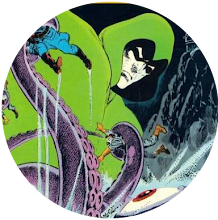 One of the things I loved in the good old days before Marvel and DC got on well enough to do collaborations was when a Marvel hero found himself up against a DC hero. Of course, thanks to that inconvenient thing known as copyright, names had to be changed to cunningly disguise what was going on.
One of the things I loved in the good old days before Marvel and DC got on well enough to do collaborations was when a Marvel hero found himself up against a DC hero. Of course, thanks to that inconvenient thing known as copyright, names had to be changed to cunningly disguise what was going on.Probably my favourite example was Avengers #70 when our heroes assembled found themselves against the Justice League of America, renamed the Squadron Sinister. And, of course, there was X-Men #107 when, under the pencil of Dave Cockrum, Marvel's mightiest mutants found themselves fighting Cockrum's previous charges the Legion of Super-Heroes in everything but name.
With Daredevil #115, it was the man without fear's turn as he found himself up against the Shadow. Obviously, they didn't call him the Shadow, they called him Death-Stalker but the silly hat, the tendency to vanish into thin air and the love of inappropriate laughter left you in no doubt who he really was.
But it wasn't that simple.
Just as the early Christian Church demonised the gods of rival religions, so Marvel demonised DC comics' heroes and, far from being a determined battler of evil, the Shadow became a bad guy out to sell secret formulae to enemy powers and had a death touch that supposedly slew all it encountered. In fact, in the issues I read, I'm not sure it ever managed to slay anyone. I seem to remember him using it on the Man-Thing, the Gladiator and DD and all lived to fight again. Oh well, what's a villain without a little hyperbole?
 |
| The Shadow might know but Daredevil doesn't. |
The story is that Foggy Nelson's sister Candace has stumbled on some documents relating to the formula that turned Ted Sallis into the Man-Thing, and now the Death Stalker's stolen them so he can sell them to whatever nation would like to create a race of pollution-breathing monsters. I suspect most nations would like to do that. Needless to say, after a bit of difficulty here and there, our hero finally succeeds in stopping him with the aid of an acid vat. To do this, he requires an incredible amount of luck. DD thinks to himself, "Where would Death-Stalker be?" On fairly flimsy grounds, he decides he might be at a chemical plant. And wouldn't you know it, the first chemical plant our hero comes across, Death-Stalker's there. Sherlock Holmes eat your heart out.
As a kid, I always had a soft spot for Daredevil, possibly because his lack of powerage made him more human and more the sort of hero that theoretically, any of us could be. As an adult, I'm not so bothered.
Reading through his adventures in the first three Essential Daredevil volumes was an oddly empty experience for me compared to the likes of Essential Avengers, Spider-Man and Thor. I found it hard to get into Gene Colan's art, and the human side of Daredevil's life, his trials and tribulations with Foggy Nelson and Karen Page, seemed dull compared to Peter Parker's. However, by the time issue #115 had come along Colan was gone and the strip was being drawn by Bob Brown. There was nothing spectacular about Brown's work but, like Sal Buscema, he was a solid story teller whose people looked like people and I do like the way he portrays Death-Stalker here, as a somewhat melodramatic, pantomime villain, never shirking the chance to adopt an arch pose.
The relationships also seem more interesting. We've had Candace Nelson added to the strip, and the Black Widow and Ivan are still lurking in the background, mostly hanging around on park benches. As a result, I do find this tale more interesting than those earlier ones, an odd example of a strip improving after what, at face value, is its classic era. It's still nothing special compared to Marvel's greatest triumphs but it carries you along painlessly and I'm not sure I have the right to ask more of Matt Murdock than that.




















---01.jpg)


















































No comments:
Post a Comment